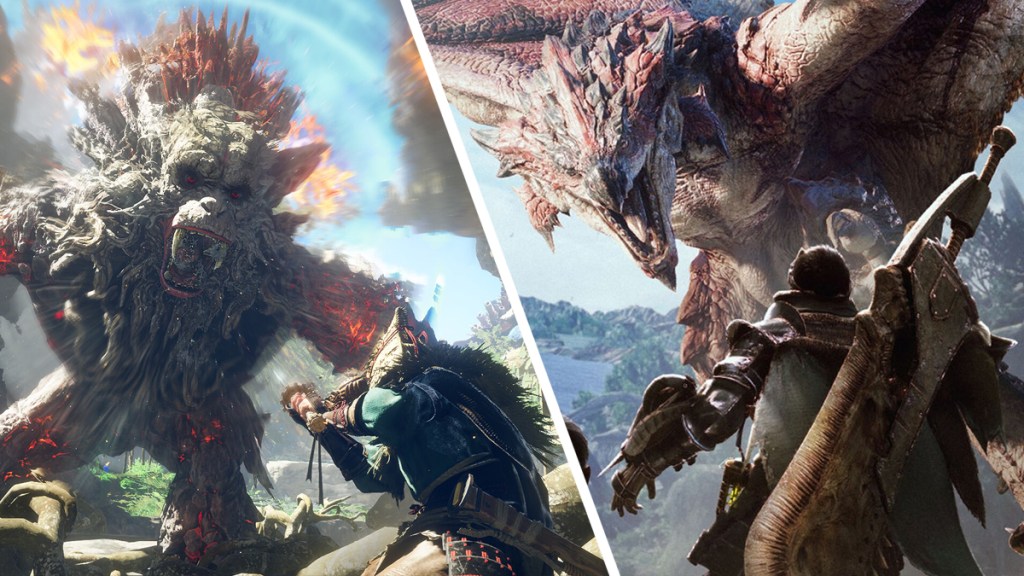During the height of the PlayStation 3 and Vita, it was common to see two or three Monster Hunter alternatives like Soul Sacrifice and Ragnarok Odyssey come out within a single year. While many had their own twists on the established blueprint, nearly all kept the general mission-based structure from Capcom’s series. Later on, we’d see some more experimentation, such as with Omega Force’s Toukiden 2, which bravely took the formula into an open world. Now fully entrenched in a new console generation, Omega Force’s Wild Hearts is the first game to push the hunting genre forward after Monster Hunter: World modernized it and took it to new heights in 2018.
The influence World has had on Wild Hearts is quite apparent from the outset. A lot of elements, such as the fluid movement and large explorable areas, feel a lot like World, so you almost get into the same groove. Likewise, the action itself finds a solid middle ground between the animation prioritization of early hunting games and giving the player more ways to recover from dangerous situations. Much of the strategy inherent to the gameplay revolves around taking advantage of foes that overextend themselves and avoiding the same kind of overreach yourself. That constant push and pull is what makes taking down monsters, which are called Kemono, so exhilarating, and learning each’s intricacies is how that strategy always evolves.

However, this is far from a clone and the major differences in Wild Hearts can make it difficult to get fully situated when you’re used to the rules of Monster Hunter. The most apparent (and interesting) change is the addition of an on-the-fly crafting mechanic that looks a lot like the one in Fortnite. While your ability to craft is limited to the resources you collect, the options are quite extensive, such as boxes that players can jump on or walls that can stun a beast if they charge into it.
It’s incredibly jarring at first and my first reaction was to just not engage with it. But this was a huge mistake since my stubbornness meant I was cutting myself short. After struggling in some early hunts, I eventually gave in and decided to embrace this unique mechanic and start building like an 11-year-old trying to win a Victory Royale. It was then that Omega Force’s game started to click as I was getting a much more unique and interesting experience. Crafting structures on the fly adds another tactical layer and made me feel like I was outsmarting the hulking, dangerous creatures, which is what a true hunt should feel like.
Crafting also lets players make objects that enhance Wild Hearts‘ exploration. Creating new fast travel spots, zip lines, and wells that extract healing water are just some of the advantages you can gain while using the game’s coolest mechanic. It’s a widespread mechanic that isn’t some gimmick, and that quality strengthens the whole experience. It all adds up to give Wild Hearts a distinct personality and flavor, one that takes it far beyond being clone status.

As with Monster Hunter, Wild Hearts truly shines in multiplayer. Taking down a giant beast isn’t just more feasible when aided by other players since new strategies and ideas are brought forth when hunting cooperatively. Coming together with others to overcome the multi-step boss fights is a real joy, and it’s helped by a pretty smooth party and matchmaking system that is unfortunately rare within the genre as Capcom has often struggled with implementing straightforward ways to play with friends (although Monster Hunter Rise was a step in the right direction).
That being said, there are still plenty of elements where World has it beat. While Wild Hearts has incredible monster designs and levels that are a joy to traverse, they never quite feel like a living, breathing biome the way that Capcom was able to achieve. The largest beasts still feel like they were dropped into the locations and you don’t really get a chance to understand how they survive. There’s also just not many opportunities for memorable emergent gameplay moments, such as leading one giant enemy to another and just being in awe of the different gameplay systems at work and interacting with each other. With beasts that don’t fit organically in the world and the lack interwoven systems, Wild Hearts‘ world still needs some work.
Despite those small shortcomings, it’s great to see a team other than Capcom innovating within the hunting space and offering up some true competition. Competition breeds innovation and it’s healthy for the industry for games like Wild Hearts to offer a viable alternative during the downtime in between Monster Hunter releases for multiple reasons. Players get to try something new and Capcom is encouraged to push itself forward. Monster Hunter is still the apex hunter here, but Wild Hearts‘ innovations mean that it isn’t the only skilled beast killer in the business.
Disclosure: Publisher provided Wild Hearts code for our feature. Played on version 1.004.000.










